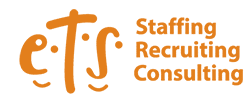
As we approach 2025, New York employers must be prepared for several significant updates to employment laws that will affect payroll, benefits, workplace safety, and more.
At ETS, we simplify workforce management by serving as the employer of record for the employees we place. This means we handle payroll, tax compliance, and benefits administration, always ensuring a seamless experience for our partners. (Looking for extra payroll support? Chat us to learn about our comprehensive payroll and hr outsourcing services.)
Our team of HR experts know that it’s essential for businesses to stay ahead of these changes to ensure compliance and continue supporting a legally sound work environment, so they’re breaking down the 2025 key employment law updates for you below.
1. Minimum Wage Increases
Effective January 1, 2025, New York will see an increase in minimum wage rates:
- From $15.00 to $15.50 per hour.
Employers should update payroll systems accordingly and communicate these changes to employees to ensure a smooth transition. These increases will continue annually through 2026, after which future wage adjustments will be tied to the Consumer Price Index for Urban Wage Earners and Clerical Workers (CPI-W).
2. Overtime Exemption Salary Thresholds
The minimum salary threshold for overtime exemptions will also increase on January 1, 2025:
- $1,161.65 per week ($60,405.80 annually).
Employers should review and adjust the salaries of salaried exempt employees to ensure they meet the new thresholds. This adjustment will affect employees classified under the executive or administrative exemptions.
3. Paid Family Leave (PFL) Enhancements
New York’s Paid Family Leave program will see improvements in 2025, with wage replacement increasing to 67% of an employee’s average weekly wage, capped at $1,177.32 per week. The employee contribution rate will adjust to 0.388% of gross wages, with a maximum annual contribution of $354.53. Employers must update PFL policies and communicate the new benefits to employees.
4. New Prenatal Leave Entitlement
Starting January 1, 2025, employers will be required to offer 20 hours of paid prenatal leave per year. This leave is in addition to other sick leave entitlements and supports pregnant employees attending prenatal care appointments and pregnancy-related health care needs. Employers must update their leave policies to include this new entitlement and ensure HR teams are trained to manage prenatal leave requests properly.
5. Clean Slate Act – Automatic Sealing of Certain Convictions
As of November 16, 2024, New York’s Clean Slate Act has taken effect, introducing automatic sealing of certain misdemeanor and felony convictions after specific timeframes. This includes:
- Felonies: Sealed after at least 8 years have passed from the date the defendant was last released from incarceration for the sentence of the conviction eligible for sealing or from the imposition of sentence if there was no incarceration.
- Misdemeanors and DWAI convictions: Sealed after 3 years.
- Exceptions: Serious crimes like murder and sex offenses are not eligible for sealing.
Employers are prohibited from inquiring about or taking adverse action based on sealed convictions. If employers conduct criminal background checks, they must provide applicants with a copy of their report and inform them of their rights to dispute inaccuracies. To avoid potential issues, employers should update hiring policies and train staff to comply with these new requirements.
6. Sunsetting of COVID-19 Paid Sick Leave
New York State’s COVID-19 Emergency Paid Sick Leave will expire on July 31, 2025. Employees will still be able to use regular paid sick leave for COVID-related absences, but businesses should be prepared for the expiration of this temporary benefit.
7. Health Savings Account (HSA) Contribution Increases
HSA contribution limits are also increasing for 2025:
- Individuals: $4,300 (up from $4,150).
- Families: $8,550 (up from $8,300).
- Catch-Up Contributions (Age 55+): Remain at $1,000.
Employers offering high-deductible health plans (HDHPs) should inform employees about these new limits and ensure their plans are updated accordingly.
8. Increased Retirement Contribution Limits for 2025
There are significant updates to retirement plan contribution limits for 2025, providing employees with more opportunities to save:
- 401(k), 403(b), 457 Plans: The contribution limit will increase to $23,500, up from $23,000.
- Catch-Up Contributions (Age 50+): The standard catch-up limit remains $7,500, but for employees aged 60-63, the limit increases to $11,250.
- IRA Contributions: The limit remains $7,000, but the income phase-out ranges for IRA eligibility have increased for 2025:
- For single filers, the phase-out range is $79,000 to $89,000 (up from $77,000 to $87,000).
- For married couples filing jointly, the phase-out range is $126,000 to $146,000 (up from $123,000 to $143,000).
- SIMPLE Plans: The contribution limit for SIMPLE plans will increase to $16,500 (up from $16,000). The catch-up contribution for employees aged 50 and over remains $3,500, but for those aged 60-63, it rises to $5,250.
Action Plan for Employers:
To navigate these changes, we recommend the following steps:
- Update Policies and Handbooks: Revise your employee handbooks to reflect new wage rates, leave entitlements, and safety requirements.
- Review Payroll Systems: Ensure your payroll system can accommodate the new wage thresholds, contribution limits, and benefits.
- Employee Communication: Notify staff of the upcoming changes, including wage increases, new leave entitlements, and the Clean Slate Act’s impact on hiring practices.
- Workplace Training: Schedule training for staff on workplace violence prevention, new leave benefits, and compliance with the Clean Slate Act.
Partnering for Success
At ETS, we are experts in navigating the evolving landscape of employment law. We specialize in understanding and managing these changes to ensure full compliance, while providing comprehensive support to our employees placed within your organization.
With our expertise, you can trust that the details are in capable hands, allowing you to focus on what matters most – the continued success and smooth operation of your business. Should you have any questions or require further guidance, our team is here to provide the support you need. Let’s work together to make 2025 a compliant and prosperous year.



